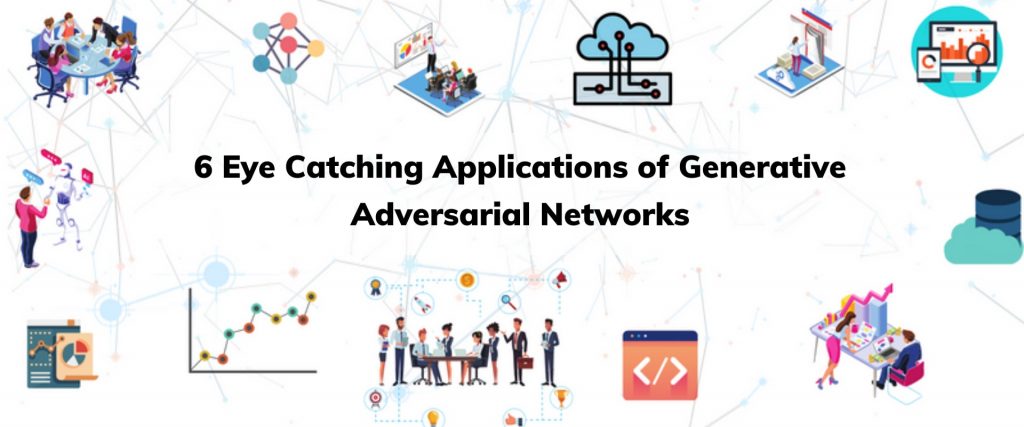GANs are a recently developed technique in machine learning for both semi-supervised and unsupervised learning. Well the reason why GANs were construct is because neural networks are generally good at predicting, classifying or solving problems. but researchers want to create a neural network which can create data for itself. that’s why they come up with the idea of Applications Of GANs.
The first GAN architecture was described in the 2014 paper by Ian Goodfellow, et al. titled “Generative Adversarial Networks.” Generative adversarial networks are a type of neural network that can generate new images from a given set of real images that are similar to the given dataset, but yet different. But how do GANs actually work?
GAN is compose of two components. a generator and a discriminator and these two components are constantly in touch with each other.
The generator generates images and the discriminator then evaluates those images and tells the generator whether or not those images are similar to what it has seen in the real world that already existed.
Briefly describing generator and discriminator model – A generator is a model which takes random noise or signal as input and then generates images while discriminator is a model which is going to stand in rivalry with the generator model. These two models are actually neural networks, that’s why the name Generative Adversarial Networks.
I haven’t got into the intricate details here. This is just a brief sketch of GANs. If you are interested in learning more about GANs, you should go through this article: “Generative Adversarial Networks“
APPLICATIONS OF GANs
Now that we have an insight of how GANs work. it’s time to dive into the fascinating applications of GANs that are commonly being use in the industry right now. Since generative adversarial networks learn to recognize and distinguish images, they find applications in industries which rely on computer vision technology such as:
1) Improving Cybersecurity using GANs
Cases of cyber threats have increased dramatically in the last few years. Organisations are taking on various security measures to prevent sensitive information from being misuse, but yet hackers are developing new techniques to exploit user data. Criminal activities like generating fake images and videos are on rise and a serious concern.
Adversarial attack is one of the methods use by hackers. Hackers edit images by adding malicious data to them. This tricks the neural network and disturbs the intended working of the algorithm. This results in non-Requiring information being use. GANs can be train to identify such instances of fraud. They can be use to make deep learning models more better.
Researchers create fake examples on purpose and use them to train the neural network. The network improves upon itself as it analyzes multiple images.
Credits – Secure Steganography Based on Generative Adversarial Networks
2) Generating anime characters using GANs
Game development and animation production are expensive and need many production artists for relatively routine tasks. GANs can automatically generate 3D models based on the 2D images provided of existing dataset. Generative Adversarial Networks can also be use for generating 2D models. The generative adversarial network is train on a dataset such as anime characters. Individuals have also tried to create Pokemon characters under the pokeGAN project. Creating emojis from human photographs is another cool application of generative adversarial networks.
Image Credits – “Towards the Automatic Anime Characters Creation with Generative Adversarial Networks”
3) Super Resolution
Christian Ledig, et al. in their 2016 paper titled “Photo-Realistic Single Image Super-Resolution Using a Generative Adversarial Network” described the use of GANs, specifically SRGAN(Super-Resolution GAN) model, to generate output images with higher, sometimes much higher, pixel resolution. Original image is convert into low resolution image and feed into SRGAN neural network to generate high resolution images.
Image Credits – “Photo-Realistic Single Image Super-Resolution Using a Generative Adversarial Network”
4) GANs for editing photographs
Image editing softwares these days doesn’t give us much flexibility to make creative changes in pictures. GANs can be in use in that place. GAN can also in demand for reconstructing images of faces to identify changes in features such as hair color, facial expressions etc.
This can help authorities identify criminals that might have undergone surgeries to modify their features. GANs can be use to create images of people at various ages. Certain details can be added to the image to make it more detailed.
Image Credits – “Invertible Conditional GANs for image editing”
5) Image-to-Image Translation
GANs can be in use for translating data from images. In image-to-image translations, GANs account for tasks such as:
- Changing sketches to color photographs.
- Converting satellite images to Google Maps.
- Translation of photos from day to night and vice versa.
- Translation of black and white photographs to color.
Image Credits – “Unpaired Image-to-Image Translation using Cycle-Consistent Adversarial Networks”
6) Improving healthcare
GANs can be used in tumor detection. They can be used to identify tumors by comparing images with a dataset of images of healthy organs. The neural network can detect anomalies in the images of a patient’s body by identifying differences when comparing them to the dataset images. Generative Adversarial Networks can also assist in drug discovery.
Credits – “The growing role of AI in the pharmaceutical industry”
CONCLUSION
however, Applications Of GANs, with ongoing research and advancements, it is expected to benefit many other industries. Unsupervised learning and generative adversarial networks are the next frontiers in AI, and we are moving towards it at a very fast pace.
written by: Chelsi Jain
reviewed by: shivani yadav
If you are Interested In Machine Learning You Can Check Machine Learning Internship Program
Also Check Other Technical And Non Technical Internship Programs

